

We may earn revenue from the products available on this page and participate in affiliate programs. Learn More ›
Vinyl siding takes a beating. From UV rays that leave a dull chalky film on its surface, to dirt and grime from leaves, birds, and insects, to stains from algae and mildew growth, your vinyl siding can get pretty nasty. You can hire a company to pressure wash your house or you can take this job on yourself. Cleaning vinyl siding isn’t difficult and only requires a few simple tools and supplies. This guide will show you how to clean vinyl siding safely and effectively.
Tools & Materials
Bobvila.com may earn a commission from purchases made through these links.
Project Overview
Working Time: 2 to 4 hours, depending on the size of the house
Total Time: 2 to 4 hours
Skill Level: Beginner
Estimated Cost: $20 to $30
Before You Begin
This guide details the best way to clean vinyl siding using a garden hose and brushes. While you can also clean your siding using a pressure washer, Niki O’Brien, operations manager at Custom Exteriors LLC, cautions homeowners against doing so as using the wrong nozzle or holding the nozzle tip too close to the surface of the siding can easily discolor or damage it.
“In our experience, the best way to clean siding is via garden hose and sprayer,” O’Brien, whose company serves parts of Colorado and Wyoming, says. “We find that pressure washing on too high a pressure can result in damage. In vinyl siding, high-pressure water can actually break all the way through.”
If you’re not sure about how to pressure wash a home safely, it’s best to leave pressure washing vinyl siding to the pros. While the methods below are certainly more time-consuming than pressure washing, you won’t run the risk of damaging your siding.
Step 1: Choose or make a cleaning solution.
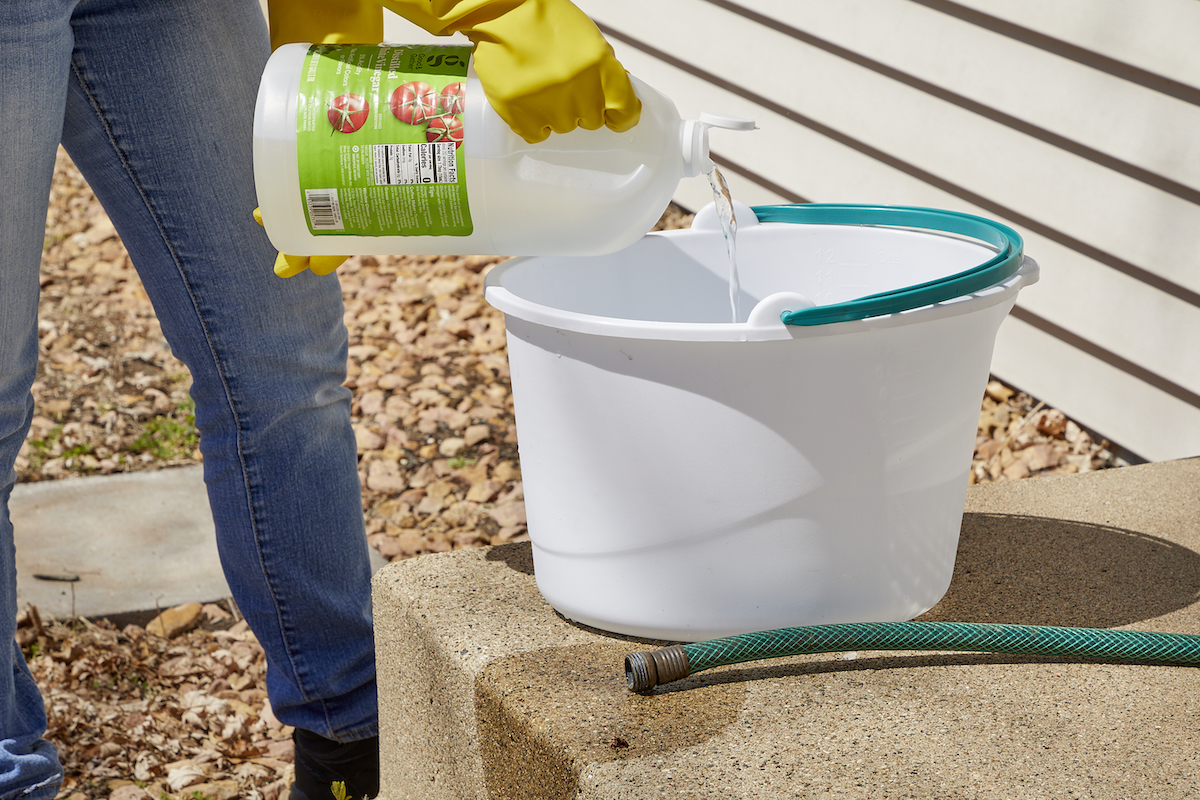
You can buy a commercial house cleaning product or make your own cleaning solution. “The best cleaners for cleaning vinyl siding by hand are really homemade cleaners typically because they are gentlest on the material,” says Andrew Prchal, co-founder and president of Gunner Roofing of Stamford, Connecticut. “You should be using cleaners as mild as possible when cleaning vinyl siding by hand so it doesn’t damage the siding,” he adds. He suggests using a simple mix of dish soap and water.
You can also make a homemade vinyl siding cleaner by mixing 70 percent water with 30 percent white vinegar. The vinegar will cut through mold and mildew buildup on the siding but won’t harm any surrounding landscaping or grass. Avoid using cleaning products that aren’t specially designed for vinyl siding, as they could damage or discolor it.
If you choose to go with a commercial exterior house cleaning product, we suggest Mold Armor E-Z House and 30 Seconds Outdoor Cleaner, both of which attach to your garden house, making it easy to apply over a broad area. Some DIYers choose to wear rubber gloves while you work, but they aren’t essential.
Step 2: Spray the siding with a garden hose.
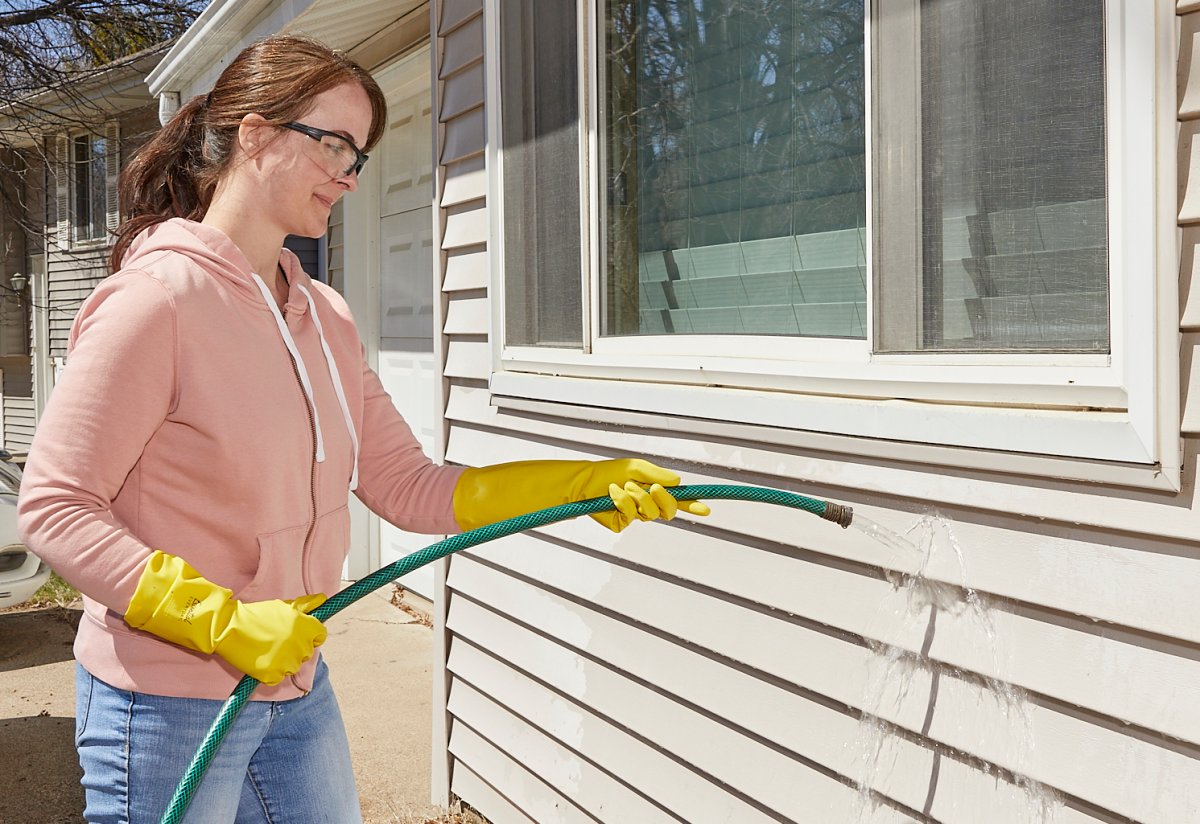
Start by using a garden hose with a sprayer attachment to remove any loose dirt or spiderwebs on your siding. If your siding is in good shape, hitting the siding with a hose may be all the exterior house cleaning it needs. “Most times, the water pressure from a garden hose will take care of the dust and debris found on your siding,” O’Brien says.

Tool Tip
Supported by Ecomax
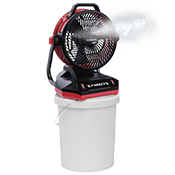
Preparing for a full day in direct sun? Enlist the help of the Ecomax Bucket Top Misting Fan to keep cool while you work outside. The 12-inch cordless fan pulls water from a bucket or garden hose, then disperses a fine mist into the surrounding area for up to 3.75 hours on a single charge (or continuously when plugged into an outdoor-rated extension cord). Two airflow speeds up to 1400 CFM and a 135-degree pivoting head enable it to precisely cool off whatever space you’re working in.
Get the Ecomax Bucket Top Misting Fan at Costco for $134.99.
Step 3: Scrub the siding, working from the top down.
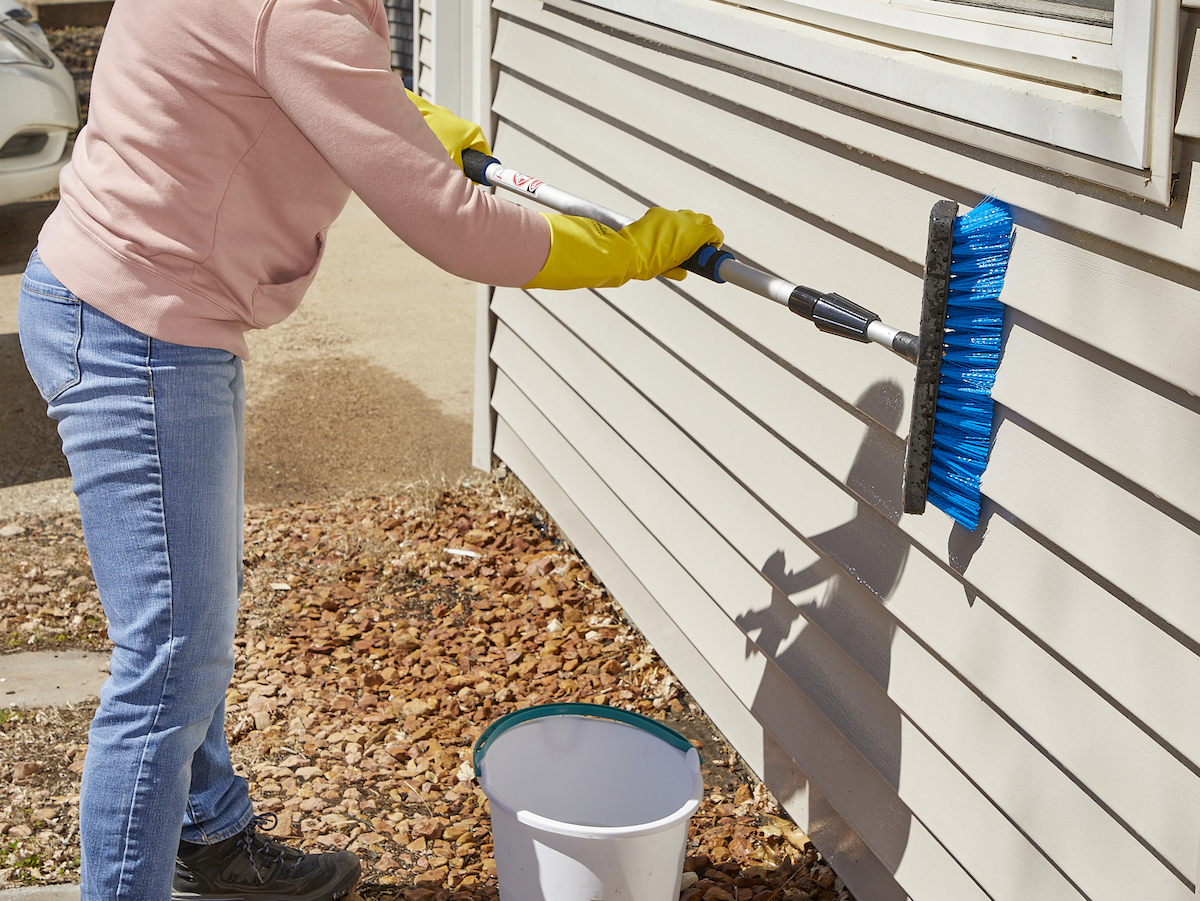
Use a soft-bristled brush to scrub the siding. Vinyl siding is durable material, but it is possible to scratch it, so avoid using a brush or scrubbing sponge that’s abrasive.
“Do not use a metal brush as this can damage the siding and scratch it,” Prchal says. He suggests using a soft brush, or even a sponge or towel.
When scrubbing, use gentle pressure. The idea is to use just enough cleaner and scrubbing action to remove dirt, O’Brien says. “Begin with the lowest pressure, soft-bristle brush, and gentlest cleaning agent possible.”
To extend your reach, use a brush with a telescoping handle. You can adjust the brush’s handle to reach the highest sections of your home—some reach as far as 30 feet. It’s also a good idea to have a smaller brush handy to clean nooks and crannies near ground level.
Begin scrubbing the vinyl. As you clean, gravity will carry the soapy water and dirt downward onto the siding below, so work from the top down, cleaning the entire length of each row before moving to the next section below it.
Step 4: Rinse off the vinegar solution.
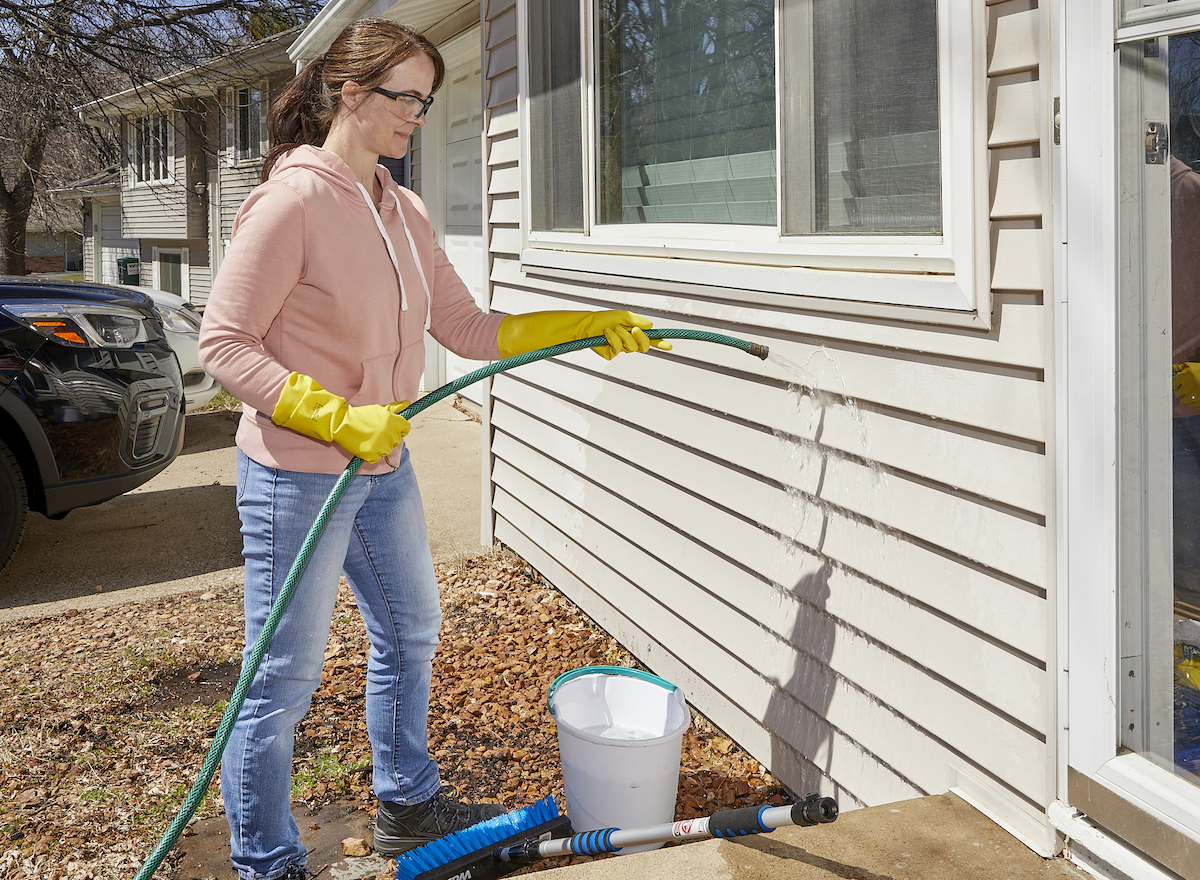
Use a garden hose with a sprayer attachment to rinse the cleaning solution off the vinyl siding. As when applying the cleaner, work from the top down to prevent dirty water from running over clean areas. Most house cleaning solutions, including this homemade vinegar mixture, are safe for plants, but you may wish to cover any nearby shrubs or plantings just in case. Avoid spraying the vinyl at an upward angle, which can force water underneath the siding. As you rinse, keep an eye out for any cracks, holes or gaps in the siding and make any necessary repairs after you finish cleaning.
Step 5: Spot clean tough stains with a scrub pad.
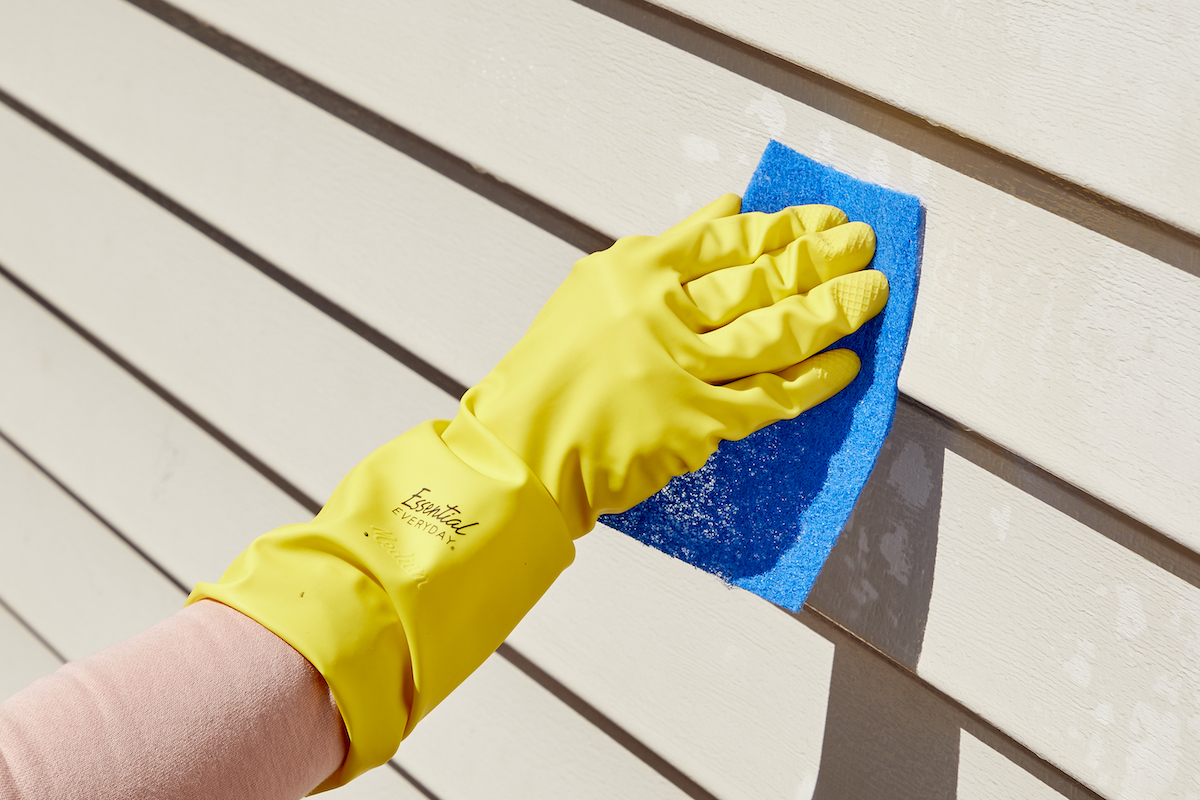
Tough stains may require more elbow grease to remove. In that case, it’s okay to scrub them with a sponge as long as it’s not so abrasive that it can scratch the surface of the vinyl. Test the scrub pad on an inconspicuous area first.

Tried-and-True Advice
“Instead of mixing small batches of cleaning solution, I found it quicker to prepare a larger batch in a pump sprayer. This way, I can spray down sections continuously without needing to go back to the bucket every few minutes.”
—Paul Rankin, Contributing Writer and Editor
How to Remove Mold and Mildew From Vinyl Siding
While the white vinegar and water mixture should be effective at removing mold and mildew from your siding, sometimes you need to take more extreme measures to get rid of the green stuff.
- Mold and mildew remover: One of the most effective ways to spot treat mold and mildew is to use a specially formulated mold and mildew remover, such as Goo Gone. This product sprays on, rinses off with water, and doesn’t use bleach, so you don’t have to worry about it discoloring your siding. It comes in a small bottle that’s designed mainly for spot treating and not large areas.
- Bleach mixture: Bleach is one of the most effective ways to kill off mold and mildew and is safe to use on siding as long as you dilute it properly. Cover nearby plants as bleach can damage them. Use a mixture of 1/2 cup of bleach to a gallon of water. Spray the mold and mildew directly, then let it sit for 15 minutes to kill off the mold. Scrub lightly to dislodge the mold spores, then rinse with water.
- Oxygen bleach: If you have nearby landscaping you want to protect, then trade out the bleach for oxygenated bleach, which will get the job done but won’t harm plants. Mix one gallon of water with a cup of oxygenated bleach and use a spray bottle to apply.
- Pressure washing: Pressure washing is the quickest and most effective way to remove any algae or mildew growth on the vinyl surface. It’s the best option if the above efforts fail, but you need to work carefully to avoid damaging the siding. Use a 15-degree nozzle to apply the cleaner and hold the nozzle 3 to 4 feet from the surface. After applying the cleaner, use a 45-degree nozzle to rinse.
Final Thoughts
The methods we have presented are useful for smaller-scale cleaning efforts, such as cleaning a small one-story home, spot cleaning dirty areas, or cleaning a shed with vinyl siding. Multi-story homes with a lot of surface area to clean and nooks and crannies in which dirt and debris can collect are difficult to clean without the use of ladders and a pressure washer. For these larger, more complex jobs, hiring a professional pressure washing company that specializes in cleaning home exteriors may make more sense.
“If you do not feel comfortable getting over to a specific area then we highly advise you not push yourself to do something you are not comfortable with,” Prchal says. “It is always better to be safe than sorry, and hire a professional.”
